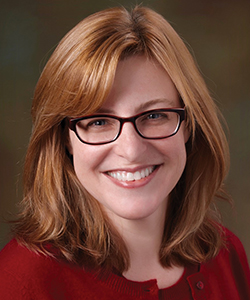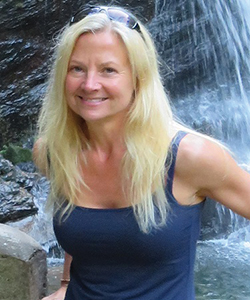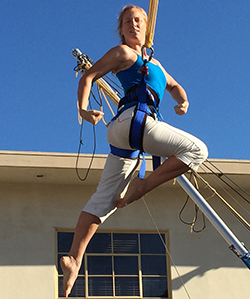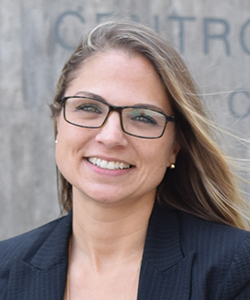Cover Story
The Many Shapes of Applied Psychological Science

Meet six researchers who are bringing psychological science into creative and practical directions: Their work stands to bolster conservation efforts, improve the usability of consumer products, create optimal indoor settings, improve safety for airline passengers, and much more. Whether testing the bounds of human endurance in a mock spaceship or pioneering the ways in which we interact with social media, these scientists are pursuing projects that serve as prime examples of applied psychological science today. We spoke to experts in neuropsychology as well as clinical, behavioral, developmental, and human factors psychology about what drove them to make their research a reality in the air, underwater, and on center stage.
Psychological Science at the Extremes
Ever wondered if you could handle a trip to Mars? How about a trek to the South Pole? Sheryl Bishop, professor and senior biostatistician at the University of Texas Medical Branch School of Nursing, is a social psychological scientist who has spent her career studying people in extreme circumstances. One of the surprises of her work: There is no such thing as the “right stuff” for extreme missions and expeditions.
“A long-duration mission requires a very different person than a short-term, task-focused mission,” she says. “A large group requires a different mind-set than a small group. So the ‘right stuff’ is really identifying the best fit for the specific mission that is being conducted. The kind of person that would do best in one mission may be the absolute worst choice for the other kind of mission.”
Bishop made sure she kept her mind and options open early in her career. She says she chose to be a generalist within the field of social psychology “so that my range of activities could be as broad as my range of interests.”
And she’s covered quite a range. She’s studied mountain climbers, deep-cave explorers, groups trekking across the desert, people living and traveling around arctic environments, and space explorers. Sometimes she can watch from a distance, but studying teams in extremis often means being there herself. That can mean getting stuck in a mock-up space station during important family events.
“My first granddaughter was born while I was participating as a team member of an all-female team at the Mars Desert Research Station in Utah in 2005. I celebrated her birth with a bottle of nonalcoholic champagne at 5 a.m. with my fellow teammates and was later interviewed as the ‘first grandmother on Mars’!” Bishop says.
Other times, her line of work means sharing some of the more extreme difficulties along with study participants. While working with Mayo Clinic researchers to study the effects of altitude on sleeping and behavior, “I had my first experience with altitude sickness at 8,000 ft. on the side of Mt. Aconcagua. My Argentinian guide had to catch me as I slid off my horse onto the narrow trail with a precipitous plunge to the river below on one side and a steep cliff wall on the other side.”
The varied nature of her work has allowed Bishop to work hand-in-hand with other psychological scientists along with engineers, neurosurgeons, and cardiologists. She says diverse viewpoints help reach deeper insights: “To get beyond the superficial examinations, we need to grapple with the hard things. And that takes the many-colored perspectives of more than one.”
Her latest research introduced Bishop to a new kind of team: design engineers and architects. A 20-year-old insight from her colleague, Washington State University Tri-Cities human factors researcher James Wise, and his subsequent investigations found that some geometric patterns in nature, called “bionomic fractals,” support cognitive function and performance. Now, Bishop is working to see whether these patterns, incorporated into the design or decoration of an indoor space, could decrease some of the problems that go along with confinement. NASA is interested in this principle to apply to spacecraft design, but Bishop sees many more possibilities. “Theoretically, we could design any environment that is stressful — think of hospitals, jails, courtrooms, doctor’s offices — with fractal properties that reduce stress and improve cognitive functioning and performance passively, and then would not have to make folks do things to counter these negative effects as much. That’s a huge win for space environments!”
From Toys to Masking Noise
Audio giant Bose recently released noise-masking “sleepbuds” — battery-powered earbuds that help people sleep better by drowning out snoring and other disturbances with soothing sounds. Psychological scientist Kathleen Kremer played a key role in the development of the product, contributing lab and human factors research to help make the product comfortable and stable for a variety of ear shapes and sleeping positions.
Since 2016, Kremer has been a User Research Engagement Lead and Researcher for the Consumer Wellness Division at the Massachusetts-based company, serving as a conduit between Bose’s research and product development teams. She formulates key questions throughout the design and development phases, oversees research and disseminates the findings, and partners with colleagues in departments ranging from engineering to sales to help drive and refine the resulting products.
Kremer says her work requires familiarity with a mix of psychological research and statistical approaches, including motivational and behavioral science.
“It requires understanding people — their needs and desires, attitudes and motivations, behaviors, capabilities and limitations, to know what products and experiences to design and how to do so in order to enable people to reach their potential,” she says.
Kremer has spent her career working in a number of different industry sectors. Prior to joining Bose, she spent 11 years at toy manufacturer Fisher-Price/Mattel, providing expertise in child development research. While many of the methodologies she used there were similar to those she now applies at Bose, she was often working with infants and children up to age 8. This introduced some distinct challenges, as her research centered on designing products for a population with limited capabilities, knowledge, and experiences. She might, for example, have had to explore whether a toddler’s inability to play an interactive game stemmed from lack of attention to the instructions, dexterity problems, or simple disinterest.
Kremer takes particular pride in her role in developing the Fisher-Price Little People Apptivity “Barnyard,” one of the first app toys ever released. Using research showing how very young children naturally try to combine physical and digital experiences, she and her colleagues created an interactive farm playset that married a physical toy farm with iPad activities. The product won an international award for its unique, interactive user experience.
Kremer says her father’s work running an innovation industry research lab inspired her to pursue a series of applied internships and consultancies while she worked toward her doctorate in Experimental Child Psychology at the University of Minnesota. Through those experiences, she discovered her passion for applying research to the design and development of technological products. And Bose, she says, provides her with plenty of opportunities to fulfill that enthusiasm.
“One of the things that has impressed me since joining Bose is the company’s emphasis on scientific research and innovation,” Kremer says. “This emphasis stems from the company being founded by MIT professor Amar Bose and is reflected in our slogan, ‘Better sound through research.’ While many companies have small pockets that focus on such activities, here it is part of our DNA and embedded in all that we do.”
The Restorative Role of Marine Life
There’s something mesmerizing about watching a school of fish or a strand of seaweed sway beneath the waves, and Deborah Cracknell, an honorary research fellow at Plymouth University and the European Centre for Environment & Human Health (University of Exeter Medical School) in the United Kingdom, has made it her job to find out why. After 12 years in the finance service industry, Cracknell returned to Plymouth University to pursue a degree in marine biology and microbiology. Upon graduating in 1998, she went on to work at the United Kingdom’s National Marine Aquarium (NMA), also in Plymouth, for 19 years.
In that time, Cracknell worked as a biologist and diving officer, an environmental manager, and the lead researcher for the aquarium. When the NMA sank an ex-Royal Naval frigate, the ex-HMS Scylla, in 2004 to create Europe’s first artificial reef off the coast of Plymouth, Cracknell was responsible for monitoring its progress across the decade that followed. Eventually a wrist injury prevented her from continuing with the more physically demanding aspects of her diving role, and Cracknell transitioned to coordinating the NMA’s research program for Plymouth University students.
In addition to liaising with universities, Cracknell’s role as lead researcher involved serving on the NMA’s Ethics Committee and advancing the aquarium’s conservation efforts — in particular, how to address the problem of plastic pollution — at environmental sustainability workshops and conferences.
Ten years into her career as a marine biologist, this — along with a chance conversation with University of Exeter Professor Michael Depledge, who was then in the process of founding the European Centre for Environment & Human Health — prompted Cracknell to enroll in a part-time PhD program in environmental psychology at Plymouth University to further her research on the restorative qualities of aquatic environments and biodiversity. She completed her PhD in 2016.
“I had observed that our visitors reacted to the exhibits in different ways, often commenting on how relaxing they found certain exhibits,” Cracknell says. “Researching ways in which the marine environment and its animals could influence human health and well-being seemed a natural progression.”
As part of her deep dive into the relationship between the Earth’s oceans and human health, Cracknell created a walking group through Natural England’s Walking for Health Initiative to provide a seaside outlet for people with special education needs and mental health problems. The group meets every Friday on the shores of Plymouth.
Since leaving the NMA last year, Cracknell has renewed her research focus on the restorative role of marine species and environments and is particularly interested in how to make these benefits more accessible to people in landlocked areas, for instance, through virtual reality technologies.
“I’m also interested in the conservation implications of these interactions — for instance, does greater engagement with marine life for health and well-being lead to a greater appreciation for marine life and, ultimately, more pro-environmental behaviors?” Cracknell says of her future research.
 Safer Skies Through the Science of Pilot Selection
Safer Skies Through the Science of Pilot Selection
She may not take to the skies herself anymore, but Diane Damos, president of Damos Aviation Services, is still flying high in her career as an aviation psychologist. As an undergraduate student at the University of Illinois in the 1960s, Damos discovered her passion for flight when a classmate suggested she take a tour of the college’s Institute of Aviation.
“I was hooked immediately,” Damos said, adding that the flight simulators in particular captured her attention. She changed her major from physics to psychology the next day and never looked back.
Damos was required to get a private pilot’s license for her PhD program, and that firsthand experience has proved invaluable since she received her doctorate in 1977.
“We could talk directly to pilots in their own language, and we knew what some of the problems were because we’d experienced them also, so it was absolutely critical,” Damos said of her time in the pilot’s seat.
During her 20 years in academia, Damos was a professor at the State University of New York at Buffalo, Arizona State University, and the University of Southern California. There, she developed pilot selection tests for the military — including the United States Navy and Air Force — the only entity with enough funding to support the years of trial and error that go into the process. After working through a university for 2 decades, Damos set out on her own to found Damos Aviation Services, an independent vehicle for her work with pilot selection systems.
The selection systems generally consist of a variety of personality and cognitive tests meant to tease out candidates’ spatial and quantitative abilities, Damos said. Overall, she explained, you want someone who is a logical thinker.
While Damos sometimes spends her days reviewing test results from smaller airlines, her work primarily focuses on consulting with airlines on how to design their selection process. She has traveled broadly throughout the course of her work, teaching classes on pilot selection all across the United States, Canada, Africa, Europe, and Asia.
Outside of the office, Damos also serves as elected president of the Association for Aviation Psychology and as an expert witness in legal cases in which a pilot has died or otherwise been forced to stop flying before retirement This involves charting the pilot’s probable career path and determining their potential lifetime earnings for consideration in the case, she said.
Damos’ current research focuses on new cognitive tests for pilot selection.
Psychological Science on the Silver Screen
Psychological scientist Jessica Cail brings new meaning to the phrase “smart as a whip”: As a neuroscientist, stuntwoman, circus performer, and scientific consultant for Hollywood, Cail’s talents are as varied as her interests.
“In reality, I didn’t set out with the intention of being any of these things. I just love to learn and I follow wherever fascination leads me,” Cail says. “My work as a scientific consultant for Hollywood feels like kind of a logical progression.”
A serendipitous moment at a San Diego Comic-Con led to Cail’s first involvement with the film industry. At a panel “humorously bashing the poor accuracy of science in popular entertainment,” she met a National Academy of Sciences representative who was touting the foundation of The Science & Entertainment Exchange, an agency that connects writers, directors, and producers who have inquiries about scientific phenomena with experts in the field.
Cail was in the perfect position to help. Originally a journalism major, she enrolled in some psychology classes during her undergraduate career and was immediately fascinated by biological psychology and psychopharmacology. In particular, she is attracted to the idea that behavioral choices could have biological bases.
“Here was everything I loved about psychology as a predictor of behavior, but even more so, because this was not subjective attitudes and tendencies pushing people in certain directions, but actual wiring and chemistry!” Cail recalls. “I felt the idea that we could control our biology by controlling our psychology was game-changing. I chose to focus on addiction, specifically how the environmental cues surrounding opiate drug use become embedded with the memory of the drug’s effects, and how breaking this psychological association could actually break the physical addiction.”
Because of her specialization, Cail often works with productions on the topics of addiction and superhero (or supervillain) enhancement logistics. For Marvel’s “Agents of S.H.I.E.L.D.,” she used her knowledge of the body’s systems and interactions to create a plausible formula for a drink that would turn a mild-mannered surgeon into the superhuman Mister Hyde.
“I decided that a high-potency anabolic-androgenic steroid would fit the bill, although those are not usually administered orally because first-pass metabolism by the liver usually breaks them down before they can do anything,” Cail explains of the scientific thinking behind the end result. “I added a liver-enzyme inhibitor to the ‘recipe’ and sent it to them along with information about Intermittent Explosive Disorder. This included behavioral characteristics (such as growing sensitivity to sound before an outburst) for the actor to work into his performance should he choose to. I found myself whooping in the living room laughing when I heard what they had done to my recipe. Perfect!”
That’s not to say Cail isn’t busy in the field of psychological science as well. As a part-time professor at Pepperdine University, she not only imparts academic knowledge to her students but also ensures they understand that there is more than one way to have a successful career.
“Not every psychology career is a single-minded line from point A to point B,” she emphasized. “I’m not sure when we stopped valuing the idea of a Renaissance Man, but I think it’s important for people to see role models of scientists as healthy, well-rounded individuals of diverse interests.”
Science in Service of the User
Behind each website and app you use stands a team of developers and designers — and, if you’re lucky, at least one psychological scientist like Jennifer Romano Bergstrom. As a user experience (UX) researcher, it’s Romano Bergstrom’s job to examine the behavioral side of products and determine how to make those products better for all of us.
“We’re really the voice of the user,” she says. “UX research is about understanding how people interact with products, understanding what works well and what doesn’t work well.”
Romano Bergstrom was researching healthy cognitive aging as a graduate student at Catholic University when she learned about an internship in the Usability Lab at the US Census Bureau.
“At the time, I didn’t know what usability or user experience was, but the internship posting talked about designing and conducting studies, analyzing and reporting findings, and those were things that I knew how to do very well,” she says.
Working in the Usability Lab to understand how users interacted with forms, surveys, and websites, had Romano Bergstrom hooked on UX.
After an internship and postdoctoral fellowship at the Census Bureau, she joined the applied research company Fors Marsh Group, where she established a UX team that worked with governmental and nongovernmental clients. When an opportunity arose at the social media giant Facebook, she made the move to San Francisco, joining what was then an 80-person UX team.
These professional transitions may seem carefully plotted, but Romano Bergstrom says they wouldn’t have happened without good old-fashioned networking at conferences.
“I knew someone back when I was at the Census Bureau who had started at Facebook. I ran into him at a conference and we just started chatting about what he was doing,” she says. “I had no idea how big Facebook was or how big the team was.”
The products at Facebook presented a radical shift in both scale and scope for Romano Bergstrom, who suddenly had millions of “clients” around the world. Of the many projects she worked on, one of her favorites was Facebook’s Safety Check.
“It’s amazing to see how people use the vast power of social media to connect during a crisis, to tell others they’re okay, or to connect and share resources,” she says.
Whether they were working on Safety Check, Facebook Lite, or aspects of Instagram’s performance, the UX team engaged in an iterative research process to understand the product from a user’s perspective. They observed people’s interactions with the product, identifying any problems, and delivered these findings back to the designers or developers. After the product was improved, the UX team would test it again to ensure that the changes actually resulted in a better user experience.
Now, Romano Bergstrom is applying her skills in a different context: teamwork. As a UX researcher at Bridgewater Associates’ Systemized Intelligence Lab, led by IBM Watson creator Dave Ferrucci, she will be examining a product designed to promote “idea meritocracy” among teammates and collaborators. Teams will be able to use the product, an artificially-intelligent coach of sorts, to ensure that their best ideas rise to the top.
According to Romano Bergstrom, having a strong scientific background gives her a noticeable edge in a diverse field that is fundamentally concerned with understanding human behavior.
“The psychological training is really important, really valuable,” she says. “Sure, anybody can ask questions, but are they asking good questions?”
Here are a few recipients of the APS James McKeen Cattell Fellow Award from past years.










APS regularly opens certain online articles for discussion on our website. Effective February 2021, you must be a logged-in APS member to post comments. By posting a comment, you agree to our Community Guidelines and the display of your profile information, including your name and affiliation. Any opinions, findings, conclusions, or recommendations present in article comments are those of the writers and do not necessarily reflect the views of APS or the article’s author. For more information, please see our Community Guidelines.
Please login with your APS account to comment.